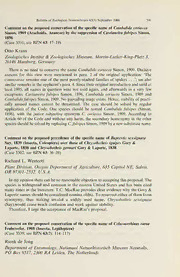
Comment on the proposed conservation of the specific name of Celaenorrhinus ratna Fruhstorfer, 1908 (Insecta, Lepidoptera) (Case 3339) PDF
Preview Comment on the proposed conservation of the specific name of Celaenorrhinus ratna Fruhstorfer, 1908 (Insecta, Lepidoptera) (Case 3339)
Bulletin ofZoological Nomenclature 63(3) September 2006 201 Comment on the proposed conservation ofthe specific name of Cambalida coriacea Simon, 1909 (Arachnida, Araneae) by the suppression of Castianeirafuhipes Simon, 1896 BZN (Case 3331; see 63: 17-19) Otto Kraus Zoologisches Institut & Zoologisches Museum, Martin-Luther-King-Platz 3, 20146 Hamburg, Germany There is no need to conserve the name Cambalida coriacea Simon, 1909. Decisive reasons for this view were mentioned in para. 2 of the original application: The coRiNNiDAE remains one of the most poorly-studied families of spiders . . .'; see also similarremarks in the applicant's para. 4. Since their original introduction and until at least 1995, all names in question were not used again, and afterwards in a very few exceptions: Castianeira fidvipes Simon, 1896, Cambalida coriacea Simon, 1909 and Cambalidafuhipes Simon, 1909. No prevailing usage exists. Hence, stability ofpracti- cally unused names cannot be threatened. The case should be solved by regular application of the Code. One species should be named Cambalida fuhipes (Simon, 1896), with the junior subjective synonym C coriacea Simon, 1909. According to Article 60 ofthe Code and without any harm, the secondary homonymy in the other speciesshouldbesolved byreplacing CfuhipesSimon, 1909 byanew substitutename. Comment on the proposed precedence ofthe specific name of Buprestis sexsignata Say, 1839 (Insecta, Coleoptera) over those of Chrysobothris ignipes Gory & Laporte, 1838 and Chrysobothris germari Gory & Laporte, 1838 (Case 3302; see BZN 63: 36-38) Richard L. Westcott Plant Division, Oregon Department ofAgriculture, 635 Capitol NE, Salem, OR 97301-2532, U.S.A. Inmyopinion therecanbeno reasonable objection to acceptingthisproposal. The species is widespread and common in the eastern United States and has been cited many times in the literature. T.C. MacRae provides clear evidence why the Gory & Laportenames should beconsidered nomina oblita. To resurrecteither ofthem from synonymy, thus making invalid a widely used name, Chrysobothris sexsignata (Say),would cause much confusion and work against stability. Therefore, I urge the acceptance of MacRae's proposal. Comment on the proposed conservation of the specific name of Celaenorrhiniis ratna Fruhstorfer, 1908 (Insecta, Lepidoptera) (Case 3339; see BZN 63(2): 114-117) Rienk de Jong Department ofEntomology, Nationaal Natuurhistorisch Museum Naturalis, PO Box 9517, 2300 RA Leiden, The Netherlands 202 Bulletin ofZoological Nomenclature 63(3) September2006 The authors have made a strong case which I fully endorse. In many cases identification is not easy among Asian Celaenorrhimts species. With ca. 100 names available it is importantthat nomenclaturalmattersdo not hamperidentification and access to literature. The authors have made a thorough search of the relevant hterature, and we can be confident that the name proposed to be suppressed has not ever been used since its introduction in 1907, except for the record mentioned. To further support their claim I like to add that the most complete worldwide catalogue ofnames in hesperiidae to date. Bridges (1994), a considerably enlarged version of Bridges (1988), incorrectly listed as Bridges (1993, 1998), does not mention Mat- sumura's name either. The correct references are: Bridges, C.A. 1983. Lepidoptera: Hesperiidae, Notes on Species-group names, 274 pp. Bridges, Urbana. Bridges, C.A. 1988. Catalogue ofHesperiidae (Lepidoptera: Rhopalocera). 590 pp. Bridges, Urbana. Bridges,C.A. 1994. CatalogueoftheFamily-group, Genus-groupandSpecies-groupnamesofthe Hesperiidae (Lepidoptera) ofthe World. 644 pp. Bridges, Urbana. Comment on the proposed conservation of Palamopus E. Hitchcock, 1845 (Ichnotaxa, Reptilia?) (Case 3348; see BZN 62: 237-239; 63: 49-50, 131-133) Emma C. Rainforth School ofTheoretical andApplied Science, Raniapo College ofNew Jersey, 505 Ramapo Valley Road, Mahwah NJ07430, U.S.A. (e-mail: [email protected]) 1. Moser (see BZN 63: 131-133, para. 1) suggests that Saiiroidichnites does not need to be suppressed because it is not a valid ichnogeneric name. However, when Saiiroidichnites was named (Hitchcock, 1837) it was used only at the ichnogeneric level (being used only in binominal combinations with ichnospecies), and not as a supra-ichnogeneric taxon; it was only later used (homonymously) as a supra- ichnogeneric taxon (Hitchcock, 1841). Thus, from its first usage, Saiiroidichnites is a vahd and available ichnogeneric name, and requires either suppression or conserva- tion. If we were to follow Moser's arguments in para. 1, and instead argue that Saiiroidichnites and the other pre-1845 ichnogenera were not (or not intended to be) ichnogeneric names (valid and/or available or otherwise), but only supra- ichnogeneric names, then the pre-1845 ichnospecies names would not be valid (validity requiring that the ichnospecific name is associated with an ichnogeneric name, whetherthat be valid oravailable ornot; Article 11.9.3). In turn, thenext valid and available names would be those published (for the most part) in 1845 - which include many objective synonyms of the earlier names. We have then completely destabilized Early Jurassic tetrapod ichnological nomenclature-because, since 1915, all workers in the field have used the older (pre-1845) names. Fortunately, all ofthe pre-1845 ichnogeneric names {Ornithichnites, Saiiroidichnites, Batrachoidichnites, Tetrapodiclmites) can be shown to have been used in binominal nomenclature (and thus used as ichnogeneric names), and so the species associated with them are valid and available (unless other reasons are present).
